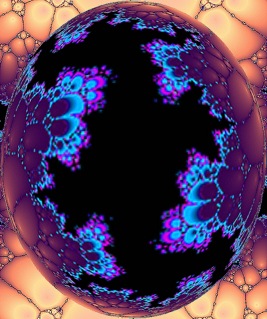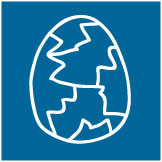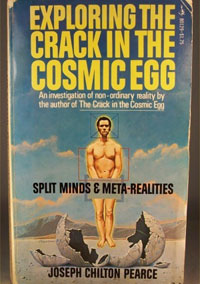
A black, blue and purple sphere against a peachie coral gradiant background, that is rippled and cracked created by Paul Steffen. He is a mathematics and art major at Gavilan. He is doing a research project dealing with mathematical fractals. His most recent focus is to put together a CD library with up to 3000 fractals on it. It will be part of his legacy to Gavilan and remain with the CGD, Math and Art departments. He uses a variety of fractal programs such as Kaos, Gravision, InkBlot and KPT5. He will be transferring to UCSC, where he will be trying to incorporate his fractal art into philosophy and creative writing. Link

In this experiment, taken
from Earthquake Games, students use eggs to simulate
the motion of Earth's plates.
You will need:
A hard-boiled egg for each student
Paper towels
Chart paper for writing observations
Markers
Procedure
1. Read a short nonfiction piece about the
layers of Earth (core, mantle, crust).
2. Make comparisons between a hard-boiled egg
and the Earth (core-yolk, mantle-white, crust-shell).
3. Introduce the concept of tectonic plates,
then instruct students to lightly crack their egg
shells until they have some small and some large
"plates".
4. Discuss movement of tectonic plates due to
forces within Earth.
5. Demonstrate how students can use their
thumbs to create pushing, pulling, and sliding forces
with their egg shell. Give them time to try out these
forces.
6. On chart paper, list some of the results
reported by students. Then ask them to describe Earth
landforms that are similar in shape to what they saw
with their eggs. Make sure to cover mountain
formation, subduction (one plate sliding over
another), and the breaking away of pieces caused by
friction.
Fun Observations
When I boiled eggs for my class, I boiled some
a bit too vigorously and a few cracked open. I showed
these to my class and they were excited to predict
why this happened. They came to the conclusion that
these eggs were hotter than the others, producing
more pressure than the shells could withstand. They
especially enjoyed examining an egg that had burst
open and had cooked egg white mounded in a very
volcano-like eruption!
Link

Exploring the
Crack in the Cosmic Egg: Split Minds &
Meta-Realities by Joseph Chilton Pearce
"An investigation of
non-ordinary reality." 1975. You can buy it second
hand from Biblio.com But then again you might not
want to after reading this
review:
Just started reading this one
last night. It has sat on my shelf for about two
years, and I think I know why. Big words. The book
is written in a style that is one of my pet
peeves: the author uses complex and relatively
difficult words to create complex and relatively
difficult sentences to get across a point that
could be said in much simpler language. Perhaps
the book should have been entitled:
Exploring the
Crack in My Cosmic Ego Trip. Ultimately an interesting
book, I'm not sure if I will be able to read it
due to series of sentences like:
"In the following
chapters I will show how culture forces each of us to
create this 'pseudoreality' structured around the
semantic effect of language, and how culture
'substitutes' a semantic reality for a direct reality
interaction. Culture's word-built world acts as a
stimulus substitute that replaces, changes, curtails,
or mutates stimuli from a real world. What we
experience as acculturated people is never the free
interaction with our life flow, that for which we are
designed by our 'primary programming.' Rather, we
experience a life flow filtrered through an ideation
scheme sharply altering our real
world."
I mean, damn. Why not just say: "We are disconnected
from true, immediate reality by the constructs of
culture." He'd still get to use some big phrases and
get his point across in a more concise way. Egghead.
says Pathless, from Pullman, WA, USA
The author
also wrote The Crack in the Cosmic Egg: New
Constructs of Mind and Reality in 2002 Amazon Book
Description writes: This enormously popular New Age
classic is finally available again to challenge the
assumptions of a new generation of readers and help
them develop their potential through new creative
modes of thinking. With a masterful synthesis of
recent discoveries in physics, biology, and
psychology, Pearce reveals the extraordinary
relationship of mind and reality and nature's
blueprint for a self-transcending humanity.
The classic work that shaped the thought of a
generation with its powerful insights into the true
nature of mind and reality.
The sum
total of our notions of what the world is--and what
we perceive its full potential to be--form a shell of
rational thought in which we reside. This logical
universe creates a vicious circle of reasoning that
robs our minds of power and prevents us from reaching
our true potential. To step beyond that circle
requires a centering and focus that today's society
assaults on every level. Through the insights of
Teilhard, Tillich, Jung, Jesus, Carlos Castaneda, and
others, Joseph Chilton Pearce provides a mode of
thinking through which imagination can escape the
mundane shell of current construct reality and leap
into a new phase of human
evolution.